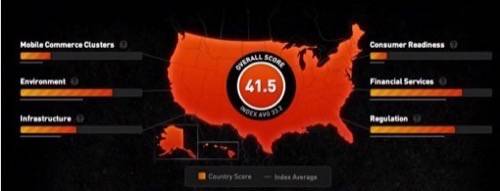
Is the world ready for mobile payments? Not quite, according to a global survey released by MasterCard yesterday. There are a variety of factors that lead will lead to mobile payments adoption across the planet, from infrastructure deployment to consumer willingness to make payments with a mobile device. The mobile payments revolution hasn’t arrived just yet, but if MasterCard can be believed, we are not far away.
MasterCard released the “MasterCard Mobile Payments Readiness Index” (MPRI) to gauge the readiness of 34 countries across the globe for mobile payments. MasterCard defines mobile payments in three different categories: peer-to-peer, mobile commerce (mCommerce) and at the point of sale (POS).
Six different factors were weighted on a 0-100 scale:
- Consumer Readiness – MasterCard surveyed 1,000 consumers in each of the 34 markets to gauge their familiarity with mobile payment, willingness to use mobile payment and current usage of the three payment types.
- Environment – Economic, technological and demographic elements, such as Internet access and per-capita income.
- Financial Services – Depth of the financial services sector, including accessibility and affordability, and penetration of digital (plastic card-based) payments.
- Infrastructure – Mobile phone penetration, network coverage and breadth of NFC terminals.
- Mobile Commerce Clusters – Partnerships among financial services, telecommunications companies, governments and technology providers.
- Regulation – Structure and efficiency of each market’s legal and governmental bodies.
These six categories show MasterCard is doing its homework. The MPRI is the result of that homework. The results are mixed, but no country has hit what MasterCard identifies as the inflection point for mass mobile payments adoption, at 65 of 100 on the company’s scale. See the results below.

According to MasterCard’s white paper on the survey results, Singapore’s top ranking is based on its infrastructure. The country has 100% mobile coverage, 70% Internet penetration and 68% mobile phone penetration. It also leads in the regulation category with “well-developed laws in relation to information and communication technology.”
In North America, the U.S. and Canada are both above average on the index. The U.S. skews toward a younger demographic, with young, affluent males making up most of the mobile payments sector, especially in the POS sector. The U.S. rates above average on willingness to use mobile payments for POS and mCommerce.

MasterCard’s conclusion on mobile payments in the U.S.:
“While scoring quite well compared to other markets in terms of integration, there remains much work to be done in the United States. That’s one of the reasons mCommerce is so far ahead of other varieties of mobile payments: The infrastructure, especially as regards the roles and responsibilities of the players – is already in place. The existence of Isis and Google Wallet do much to boost the United States’ score; but until both these projects begin to achieve air speed by engaging all players, it’s still in the early days.”
The needs of mobile payments vary in scope between developed and emerging worlds. For instance, Kenya is No. 4 on MasterCard’s index despite having little infrastructure or mobile commerce clusters. Yet, it is precisely this lack of infrastructure that has led Kenya to be one of the most ready countries in the world for mobile payments because it is building a new transactional model almost from scratch. That kind of flexibility makes developing mobile payment systems easier. For instance, take a look at M-Pesa, a peer-to-peer mobile payments system that works without banks or financial services organizations (such as MasterCard). M-Pesa is administered through IBM for Vodafone, one of the largest telecommunications companies in the world. It is an example of how technology is used to fulfill a need (in this case, easy transactions) as opposed to artificially disrupting an entrenched market that will be slow to change.
That is where MasterCard and much of the financial ecosystem may be seeing mobile payments through rose-colored glasses. For instance, why do mobile payments skew heavily toward young males in developed countries? The answer, more or less, is because it is cool. The actual need for mobile payments (NFC or otherwise) is not as clear in the U.S. as it is in other countries, like Kenya and Singapore. Mobile commerce does well in the U.S. because the existing infrastructure is in place for it to succeed. It has robust carrier billing options, PayPal and other online payment processors, as well as retail destinations like Amazon, eBay and others. The need for a peer-to-peer payment system in the U.S. is a novelty, because money can be switched easily via bank transfers, checks or other means. As for POS integration, it remains to be seen how robust that market segment becomes as retailers and consumers decide whether NFC, beam technologies and/or QR codes really add more value to the transaction process.
MasterCard has identified what it will take to create a true mobile payments ecosystem in many countries across the world. What it fails to recognize is that none of this is a foregone conclusion. Reading MasterCard’s MPRI, you get the feeling that the payment processor wants mobile payments to become a worldwide reality. It identifies an MRPI score of 60 or more as the inflection point at which a country becomes ready for mass adoption of mobile payments. The question then becomes: Even if a country does hit that inflection point, will it actually develop a robust mobile payments system?

MasterCard presupposes that there is a distinct need for mobile payments. As we have seen, that already is a reality in places like Kenya. But in developed countries, mobile payments are not based on need, but rather on creating extra value for the consumer. Whether mobile payments will deliver an easy, seamless ecosystem that creates that kind of value (such as deals, offers and data) remains to be seen.

















